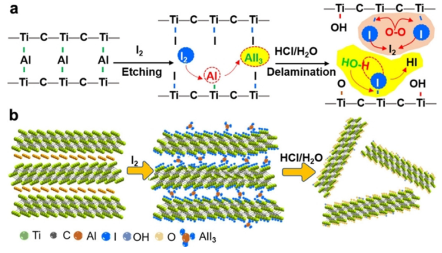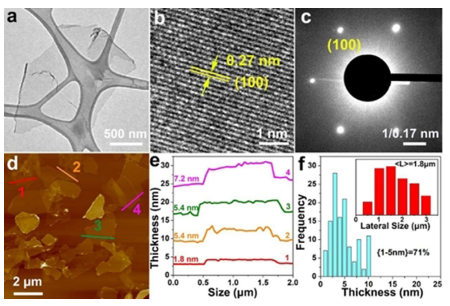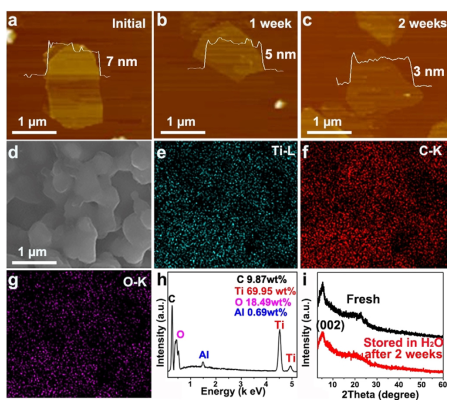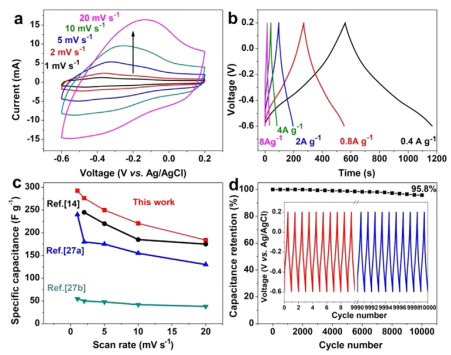
hotline:
17715390137
Tel/Wechat:
18101240246 (Technology)
0512-68565571
Email:mxenes@163.com (Sales Engineer)bkxc.bonnie@gmail.com
Scan the code to follow or search the official account on WeChat:
2D Materials Fronrier After paying attention,
click on the lower right corner to contact us,
Enter enterprise WeChat.
Professional Services Online



Two-dimensional (2D) transition metal carbides, nitrides and carbonitrides MXenes are a rising star in the 2D material system. Among the many MXene materials synthesized in the current experiment, titanium carbide (Ti3C2) is the most widely studied type of MXene, which can be used in many different fields, including energy storage and conversion, electromagnetic shielding, water purification, gas/ Biosensors, lubricants and catalysis are mainly due to their metallic conductivity and controllable surface functional groups.
Up to now, the chemical etching of MAX phase Ti3AlC2 is mainly based on fluoric acid or salt, such as hydrofluoric acid and hydrochloric acid/lithium fluoride. This kind of traditional etchant can selectively etch the Al atomic layer and effectively remove it. AlF3, which is essential for the continuous diffusion of the etchant and the complete etching of the Al atomic layer. However, for MXene nanosheets, severe etching reactions and oxygen dissolved in water will introduce additional structural defects and promote its conversion to TiO2. At the same time, the toxicity of fluorine-based etchant further hinders the sustainable commercial synthesis of MXene.

Recently, Prof. Feng Xinliang, Dr. Sheng Yang and Dr. Ali Shaygan Nia from the Technical University of Dresden, Germany, jointly published the title: Ambient-Stable Two-Dimensional Titanium Carbide (MXene) in the top international academic journal Angew. Chem. Int. Ed. The research paper of Enabled by Iodine Etching reports a fluorine-free MXene etching method, which uses iodine for etching in anhydrous acetonitrile, followed by stripping in a hydrochloric acid solution. The etching reaction is kept at 100°C to ensure the formation of Ti3C2Ix, which can be further transformed into Ti3C2Tx MXene nanosheets with suitable size and high oxygen content. More than 71% of the nanosheets have a thickness of less than 5nm and can maintain stability for at least two weeks in the dispersion.


Figure 1. Schematic diagram of the iodine-assisted etching and stripping process for 2D MXene.

Figure 2.2 XRD images, SEM images, high-resolution XPS spectra and analysis of the etching mechanism of the iodine-assisted etching and stripping process of D MXene.

Figure 3. Structural characterization of 2D MXene prepared by iodine-assisted etching.

Figure 4. Room temperature stability of 2D MXene prepared by iodine-assisted etching.

Figure 5. Electrochemical performance test of 2D MXene prepared by iodine-assisted etching as a supercapacitor electrode material.

The iodine-assisted etching strategy proposed in this paper can successfully prepare high-yield oxygen-rich MXene nanosheets with large size (1.8μm) and ideal thickness (less than 5nm). Thanks to the etching process in a non-aqueous environment, the 2D iodine-etched MXene exhibits excellent structural stability and can maintain stability for more than two weeks in water, which is better than the traditional fluorine-etched MXene. The stripped MXene nanosheets have sufficient oxygen-containing functional groups, and the assembled supercapacitor has a higher mass specific capacitance (293 F g-1) and outstanding cycle stability, which is better than most reported MXene materials. At the same time, the MXene film obtained by suction filtration has a higher conductivity of 1250 S cm-1, which is close to the conductivity of the MXene film obtained by traditional etching (1500 S cm-1). This strategy has an enlightening effect on the future development direction of other types of MXene.
Literature link:
doi.org/10.1002/anie.202015627

| Reminder: Beijing Beike New Material Technology Co., Ltd. supplies products only for scientific research, not for humans |
| All rights reserved © 2019 beijing beike new material Technology Co., Ltd 京ICP备16054715-2号 |